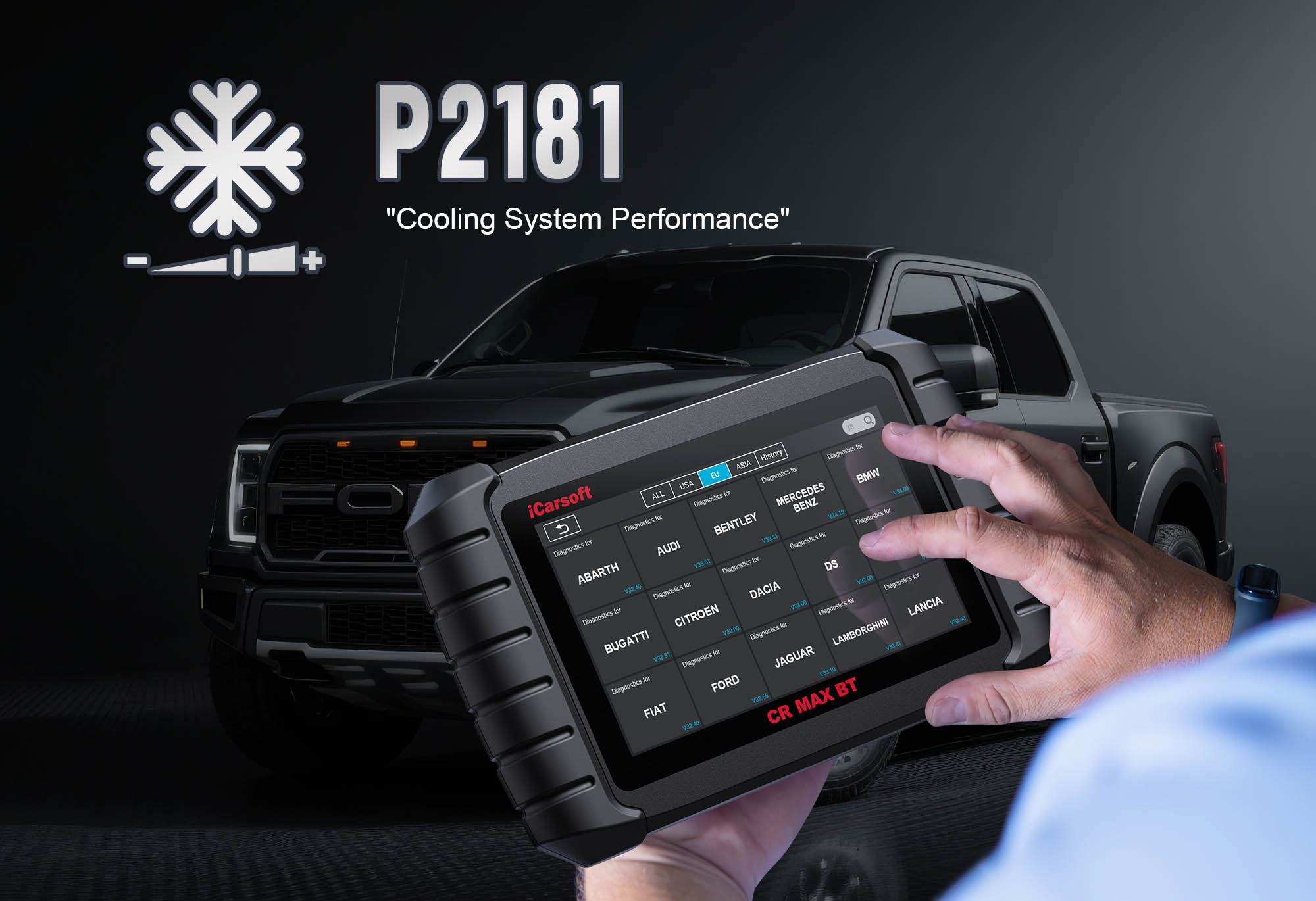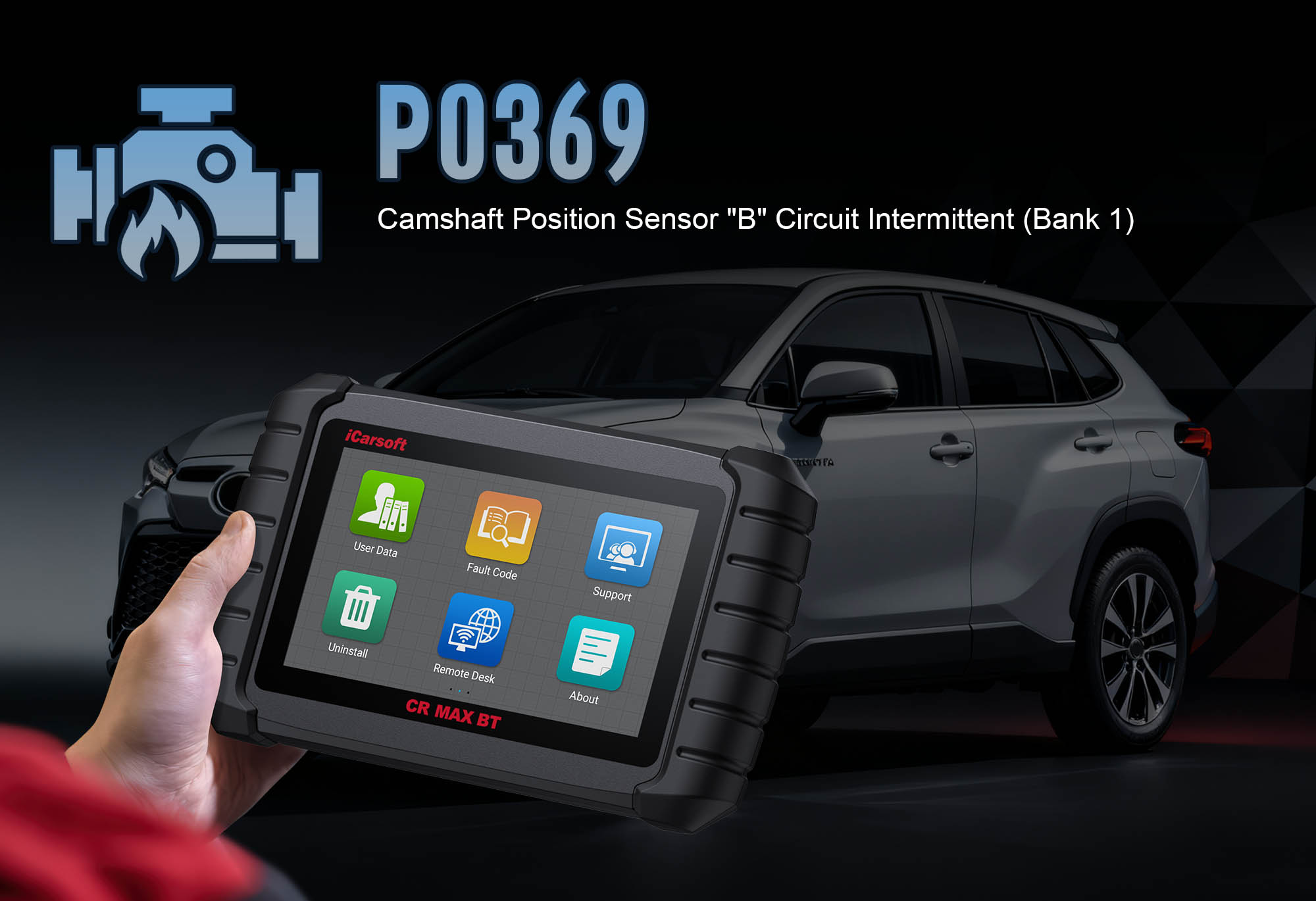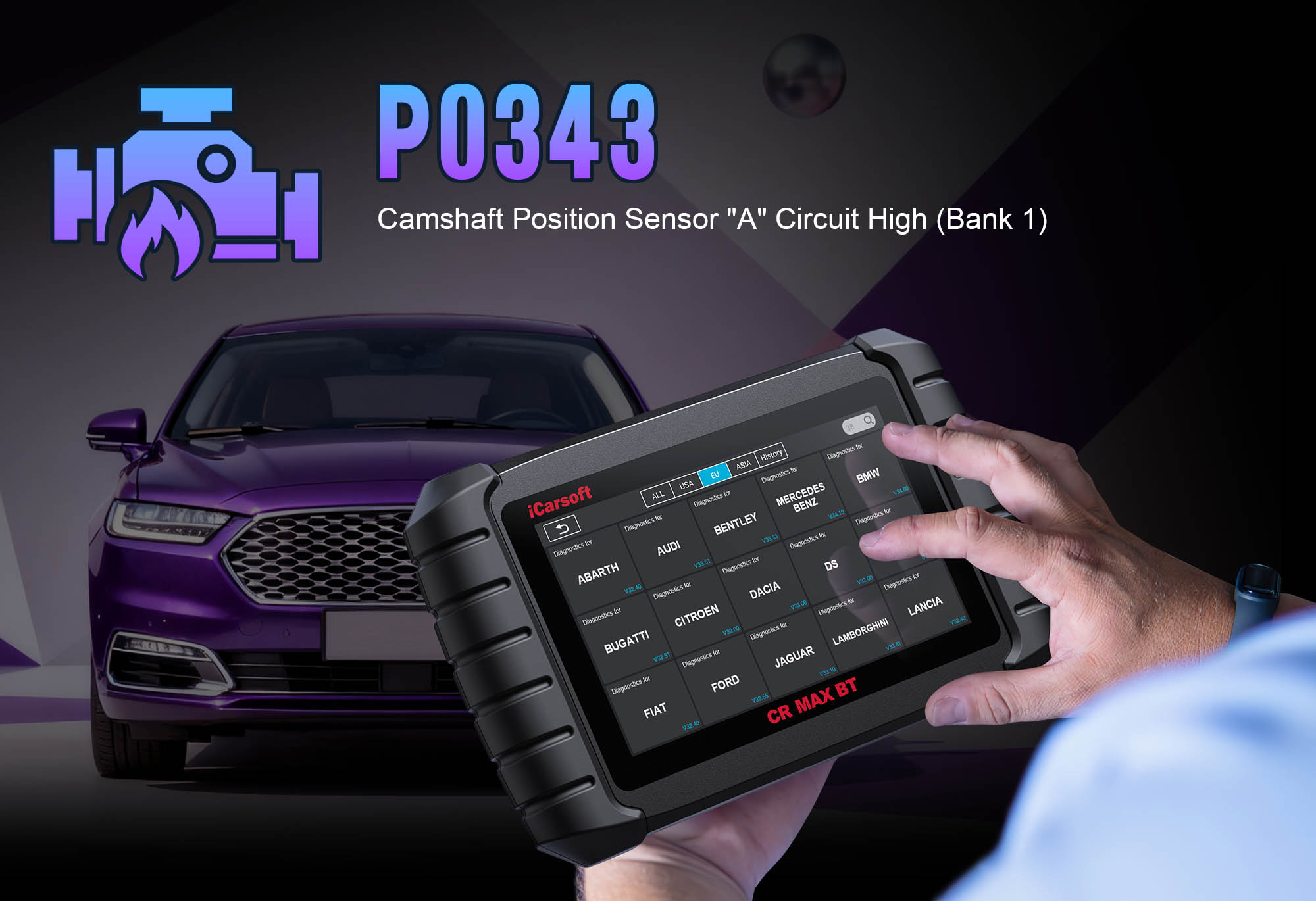Diagnose & Clear P2181 with iCarsoft CR MAX BT: Fix Coolant Temperature Sensor Circuit Range/Performance (Bank 1 Sensor 1)
If your check engine light illuminates and you notice erratic engine temperature readings or poor fuel efficiency, a scan may return P2181. This OBD-II code stands for "Coolant Temperature Sensor Circuit Range/Performance (Bank 1 Sensor 1)"—indicating the Engine Control Module (ECM) has detected that the engine coolant temperature (ECT) sensor is sending implausible or out-of-range data.
The ECT sensor is critical for engine management, monitoring coolant temperature to adjust fuel injection, ignition timing, and idle speed. At cold start, it signals the ECM to enrich the fuel mixture; at operating temperature, it helps maintain optimal combustion. When P2181 occurs, the ECM receives temperature readings that don’t align with other sensors (e.g., intake air temperature), leading to inefficient fuel use, rough idling, or overheating risks.
Basic scanners may only flag "coolant sensor fault" but can’t compare sensor data or test circuit integrity. The iCarsoft CR MAX BT—with its live temperature correlation, voltage testing, and sensor response analysis—solves this. Let’s explore how to diagnose and resolve P2181 using this advanced tool.
 iCarsoft CR MAX BT in action: Live data monitoring for P2181 coolant temperature sensor diagnosis
iCarsoft CR MAX BT in action: Live data monitoring for P2181 coolant temperature sensor diagnosis
Understanding P2181: Causes & Key Symptoms
A malfunctioning ECT sensor disrupts temperature-based engine adjustments, leading to distinct performance issues:
Key Symptoms of P2181
-
Check Engine Light: Illuminates when the ECM detects ECT readings that are static, jump erratically, or don’t match expected values (e.g., "Sensor reads 32°F when engine is hot").
-
Erratic Temperature Gauge: The dashboard gauge may show incorrect readings (e.g., stays on "cold" even when the engine is warm) or fluctuate rapidly.
-
Poor Fuel Economy: Incorrect temperature data causes the ECM to maintain a rich fuel mixture longer than needed, reducing MPG by 10–20%.
-
Hard Starting in Cold Weather: The ECM may not enrich the fuel mixture sufficiently if the sensor falsely reads "warm."
-
Overheating Risks: In rare cases, a sensor stuck on "cold" can prevent the cooling fan from activating, leading to overheating.
-
Rough Idle or Hesitation: Incorrect fuel injection timing (based on bad temperature data) causes unstable idle or acceleration delays.
Common Causes of P2181
-
Faulty ECT Sensor: Internal electrical failure (e.g., a broken thermistor) causes inaccurate resistance/temperature readings.
-
Damaged Wiring or Connector: Frayed wires, corroded terminals, or loose plugs in the ECT circuit disrupt signal transmission.
-
Coolant Contamination: Oil or debris in the coolant (from a blown head gasket) can coat the sensor, slowing its response.
-
Thermostat Failure: A stuck-open thermostat keeps the engine too cold, causing the ECT sensor to read abnormally low values.
-
ECM Malfunction (Rare): A faulty module may misinterpret valid sensor data, usually paired with communication codes (e.g., U0100).
-
Sensor Installation Issue: A loose sensor or damaged O-ring allows coolant leaks, affecting temperature detection.
Why iCarsoft CR MAX BT Excels at Diagnosing P2181
The CR MAX BT outperforms basic tools with features tailored to coolant temperature diagnostics:
Live Temperature Correlation
Compares ECT sensor data with intake air temperature (IAT), oil temperature, and ambient temperature to spot inconsistencies (e.g., "ECT = 212°F, IAT = 70°F—implausible").
Voltage Response Testing
Tracks ECT sensor voltage as the engine warms, verifying it drops smoothly from ~5V (cold) to ~0.5V (hot)—identifying erratic patterns.
3D Component Diagrams
Preloaded schematics show the ECT sensor location (usually on the cylinder head or engine block, near the thermostat) for 80+ makes (e.g., Chevrolet, Honda, Volkswagen, Mercedes).
Coolant System Integration
Monitors cooling fan activation, thermostat opening, and coolant flow to link ECT issues to mechanical faults (e.g., stuck thermostat).
Freeze Frame Analysis
Reviews conditions when P2181 was triggered (e.g., "Engine running 10 minutes, ECT = 50°F") to contextualize the fault.
Sensor Resistance Testing
Built-in multimeter function measures ECT sensor resistance at different temperatures, comparing to manufacturer specs.
Step-by-Step: Diagnose P2181 with iCarsoft CR MAX BT
-
Connect & Confirm the Code
Plug the CR MAX BT into your vehicle’s OBD-II port and pair it with your smartphone/tablet via the iCarsoft app (Bluetooth setup takes 30 seconds). Select your vehicle using Auto VIN Scan (reads VIN instantly) or manual entry (make/model/year/engine). Navigate to Engine > Fault Codes > Read Codes to confirm P2181. Tap Code Details for vehicle-specific insights (e.g., "Honda: ECT Sensor Voltage = 4.9V – Stuck High (Cold Engine Only)").
-
Locate the ECT Sensor (Bank 1 Sensor 1)
Use the CR MAX BT to avoid confusion: Go to Component Location > Engine > Cooling System > ECT Sensor (Bank 1). The app displays a 3D diagram: Bank 1 is the cylinder bank containing cylinder #1. The ECT sensor is typically a 2-wire sensor screwed into the cylinder head or engine block, with a connector near the top.
-
Analyze Live Temperature & Voltage Data
Real-time data reveals sensor inconsistencies: Start the engine and let it idle—monitor for 10–15 minutes as it warms to operating temperature. In the app, go to Engine > Live Data > Temperature Sensors and track:
-
Engine Coolant Temperature (ECT): Should rise steadily from ambient temperature to 180–220°F (82–104°C) as the engine warms. P2181 = static reading, sudden jumps, or failure to reach operating range.
-
Intake Air Temperature (IAT): Should align with ambient temperature at startup, then rise slightly. A large gap between ECT and IAT (e.g., ECT = 60°F, IAT = 90°F after 5 minutes) indicates a faulty ECT sensor.
-
ECT Sensor Voltage: Should start at ~5V (cold) and drop gradually to ~0.5–1V at operating temperature. Spikes or a flat line = sensor or circuit fault.
-
Check for Thermostat or Cooling System Issues
A stuck thermostat often mimics ECT sensor faults—verify with the CR MAX BT: Navigate to Engine > Live Data > Cooling System. Monitor "ECT" and "Cooling Fan Status":
-
The thermostat should open once ECT reaches 180–195°F (82–90°C), causing a brief temperature drop. No drop = stuck-closed thermostat.
-
The cooling fan should activate when ECT exceeds 220–230°F (104–110°C). If ECT stays below 180°F (82°C) indefinitely, the thermostat is stuck open.
If thermostat issues are confirmed, address them first—they can trigger P2181 independently of the ECT sensor.
-
Inspect the ECT Sensor, Connector & Coolant
Physical issues are often the cause—check with guidance from the CR MAX BT:
-
Sensor Inspection: Ensure the engine is cool. Locate the ECT sensor using the app’s diagram. Disconnect the connector and remove the sensor (use a socket wrench). Check for:
-
Oil or debris coating the sensor tip (sign of coolant contamination).
-
Physical damage (cracks in the sensor housing).
-
A worn or damaged O-ring (causes coolant leaks).
-
Connector Check: Examine the sensor plug for corrosion (white/green deposits), bent pins, or water intrusion. Clean terminals with electrical contact cleaner.
-
Coolant Condition: Use the app’s Coolant Check Guide to inspect fluid level and quality. Low, discolored, or oily coolant = flush the system and fix leaks before replacing the sensor.
-
Test the ECT Sensor’s Electrical Function
A faulty sensor or circuit is a top cause—test with the CR MAX BT:
-
Resistance Test (Cold & Warm): Measure ECT sensor resistance at room temperature (using the app’s Multimeter Function). Compare to manufacturer specs (e.g., 2,000–3,000 ohms at 77°F/25°C). Warm the sensor gently (e.g., with a hair dryer) and re-measure—resistance should drop steadily (e.g., 200–300 ohms at 212°F/100°C). Erratic or no change = replace the sensor.
-
Circuit Continuity Test: Check continuity between the ECT sensor connector and the ECM (use the app’s wiring diagram). >1 ohm = broken wire—repair with heat-shrink connectors.
-
Voltage Supply Test: Turn the ignition to "On" (engine off). Measure voltage at the sensor’s signal wire (via the connector). Normal = 4.5–5V (from the ECM). 0V = check ECM wiring or fuse.
-
Repair & Clear P2181
Fix the Root Cause:
-
Replace the ECT sensor (use OEM for accuracy—check the app’s Part Lookup). Install a new O-ring to prevent leaks.
-
Repair damaged wiring with heat-shrink connectors; replace severely corroded harnesses.
-
Replace a stuck thermostat (follow the app’s Thermostat Replacement Guide).
-
Flush the cooling system if coolant is contaminated (use the app’s Fluid Service Guide for steps).
Clear the Code: In the app, go to Engine > Fault Codes > Clear Codes to delete P2181.
-
Validate the Repair
Confirm the ECT sensor and cooling system work correctly:
-
Start the engine and monitor live data—ECT should rise steadily to operating temperature (180–220°F).
-
Verify the cooling fan activates when ECT exceeds the threshold (e.g., 225°F).
-
Test drive in varying conditions (city/highway) to check for improved fuel efficiency and stable idle.
-
Re-scan with the CR MAX BT: No P2181 recurrence = successful repair.
Preventing P2181 Recurrence
The CR MAX BT helps maintain reliable ECT sensor performance long-term:
-
Coolant System Maintenance: Use the app’s Service Reminder to flush coolant every 60,000–100,000 miles, replacing with the manufacturer-recommended type.
-
Sensor Inspection: Include the ECT sensor in annual tune-ups—check for corrosion and ensure the connector is secure.
-
Thermostat Checks: Replace the thermostat every 100,000 miles to prevent sticking, which can damage the ECT sensor.
-
Regular Scans: Use the CR MAX BT’s Quick Scan quarterly to monitor ECT readings and catch early inconsistencies.
Conclusion
P2181’s coolant temperature sensor fault disrupts critical engine adjustments, but the iCarsoft CR MAX BT simplifies diagnosis with live data correlation, resistance testing, and system integration. Whether replacing a sensor, fixing wiring, or addressing thermostat issues, this tool ensures you resolve the root cause—restoring fuel efficiency, reliable starting, and proper engine temperature regulation.
With the CR MAX BT, tackling "coolant temperature sensor range faults" becomes a precise process, keeping your engine running optimally in all conditions.

 iCarsoft CR MAX BT in action: Live data monitoring for P2181 coolant temperature sensor diagnosis
iCarsoft CR MAX BT in action: Live data monitoring for P2181 coolant temperature sensor diagnosis



